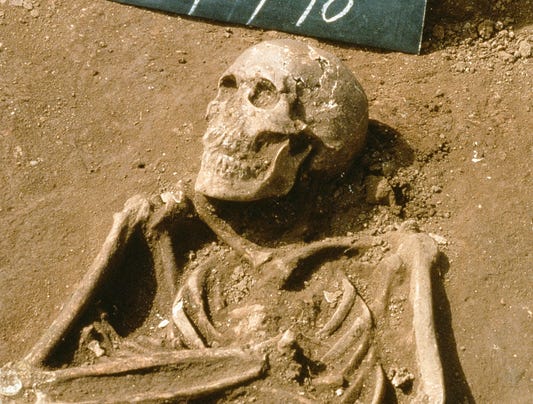The bold colonizers who accompanied Christopher Columbus on his second trip to the New World faced obstacles impossible to grasp in today's hyperconnected globe. The seafarers planned to settle in an unknown land far from home, amongNative Americans who were often hostile. Today, research suggests that they bore an additional burden: scurvy, which set in during the long sail across the Atlantic.
Historical documents and analysis of skeletons buried at Columbus' short-lived settlement in what is now the Dominican Republic hint that the colonists suffered from severe scurvy, which is caused by vitamin C deficiency and results in pain, debilitating fatigue and sometimes tooth loss. The study sheds light on what exactly ailed the settlers — something that documents of the day did not fully explain.
Though colonizers were on the mend by the time they died, the disease may have contributed to a wave of deaths and the ultimate failure of the colony, which Columbus intended as Spain's first permanent settlement in the New World.
"After sustained scurvy, the crewmembers must have felt very, very, very weak," says study author Vera Tiesler of the Autonomous University of Yucatan in Mexico. "Everybody was ill and suffering."
Tiesler's team examined 27 skeletons buried in the cemetery at La Isabela, the ill-fated colony that Columbus founded in 1494 on the Caribbean island of Hispaniola.
Twenty of 27 skeletons showed bone markings suggestive of scurvy, the team argues in a new paper in the International Journal of Osteoarchaeology. The team — which includes researchers from Mexico, the Dominican Republic and Italy — says the finding of scurvy is bolstered by contemporary accounts of what the settlers ate during their long passage from Spain to the Americas. Provisions for the 1,000-plus seafarers included bacon, sea biscuit and the like, none of it rich in vitamin C, Tiesler says.
All the same, the voyagers might have avoided scurvy if they'd sailed directly from Spain to La Isabela, a journey of two months or less. It can take up to three months of vitamin C deprivation for scurvy to set in. But when Columbus and his companions reached the Americas, they landed at a Hispaniola outpost where Columbus had left nearly 40 men from his 1492 voyage of discovery. He returned to find all of those men dead, perhaps killed by the local Taino people. So the ships set sail again and spent another month at sea before landing at the site that would become La Isabela.
"It was especially long, this trip — three months. And that's exactly the time scurvy needs to be in full bloom," Tiesler says.
By then, the voyagers were weak and malnourished, some of the provisions having spoiled on the trip. The sea off Hispaniola teems with fish, and the Taino ate guavas and a form of pineapple, both rich in vitamin C. But the settlers seem to have turned up their noses at the local foods, at least at first. Their attempts at farming failed, and the settlers sent desperate letters to Spain requesting food such as salted fish and salt pork. Many colonists died, though the number is not clear, and La Isabela was abandoned in 1498.
La Isabela has been nicknamed "Hell in Hispaniola," says Kathleen Deagan, an archaeologist at the Florida Museum of Natural History who has excavated the site. "People complained bitterly about the starvation and misery." The new data dovetail with her own findings, which include evidence from tools and other items that the Spanish were trying to re-create Spain, rather than adapt to the environment.
Other experts are split on whether the skeletons show conclusive signs of scurvy. Darlene Weston of the University of British Columbia says via e-mail that it's "notoriously difficult" to diagnose scurvy without examining the skulls, which Tiesler's team couldn't do. But George Maat of Leiden University Medical Center in the Netherlands says via e-mail the study makes "a strong case" for scurvy.
Maat also says the bones show signs of partial healing from scurvy, meaning that the settlers were starting to take in some vitamin C before they died. But they got too little to heal completely, even though they were living on a tropical island rich in fruit and other fresh food.
"These are people who plan to come and make their settlement just like Spain," says historian Allyson Poska of the University of Mary Washington in Virginia. "They dug in their heels and said, 'I'm only going to eat what I know,' just like a lot of people. And they paid the price."



No comments:
Post a Comment